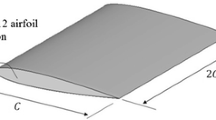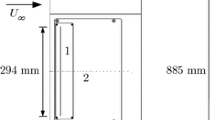Abstract
The effects of jet width on blowing and suction flow control were evaluated for a NACA 0012 airfoil. RANS equations were employed in conjunction with a Menter’s shear stress turbulent model. Tangential and perpendicular blowing at the trailing edge and perpendicular suction at the leading edge were applied on the airfoil upper surface. The jet widths were varied from 1.5% to 4% of the chord length, and the jet velocity was 0.3 and 0.5 of the free-stream velocity. Results of this study demonstrated that when the blowing jet width increases, the lift-to-drag ratio rises continuously in tangential blowing and decreases quasi-linearly in perpendicular blowing. The jet widths of 3.5% and 4% of the chord length are the most effective amounts for tangential blowing, and smaller jet widths are more effective for perpendicular blowing. The lift-to-drag ratio improves when the suction jet width increases and reaches its maximum value at 2.5% of the chord length.
Similar content being viewed by others
References
D. C. Hazen, Boundary layer control, Journal of Fluid Mechanics, 29 (1968) 200–208.
M. Gad-el-hak, Control flow: Passive, active and reactive flow management, Cambridge University Press, United Kingdom (2000) 25–35.
H. Schlichting, Boundary layer theory, McGraw-Hill, New York, USA (1968) 347–362.
E. J. Richards and C. H. Burge, An airfoil designed to give laminar flow over the surface with boundary layer suction, Aeronautical Research Council, R&M 2263 (1943).
S. W. Walker and W. G. Raymer, Wind tunnel test on the 30 percent symmetrical griffth aerofoil with ejection of air, Aeronautical Research Council, R&M 2475 (1946).
A. L. Braslow, A history of suction type laminar flow control with emphasis on flight research, NASA History Division, Monograph in Aerospace History, 13 (1999).
R. E Dannenberg and J. A. Weiberg, Section characteristics of a 10.5 percent thick airfoil with area suction as affected by chordwise distribution of permeability, NACA Technical Note 2847 (1952).
D. M. Heugen, An experimental study of a symmetrical aerofoil with a rear suction slot and a retractable flap, Journal of Royal Aeronautical Society, 57 (1953).
R. E. Dannenberg and J. A. Weiberg, Section characteristics of an NACA0006 airfoil with area suction near the leading edge, NACA Technical Note 3285 (1954).
H. J. Howe and B. J. Neumann, An experimental evaluation of a low propulsive power discrete suction concept applied to an axisymmetric vehicle, David W. Taylor Naval Ship R&D Center TM 16-82/02 (1982).
S. Dirlik, K. Kimmel, A. Sekelsky and J. Slomski, Experimental evaluation of a 50-percent thick airfoil with blowing and suction boundary layer control, AIAA Paper No. AIAA-92-4500 (1992).
Y. Guowei, W. Shanwu, L. Ningyu and Z. Lixian, Control of unsteady vertical lift on an airfoil by leading-edge blowing suction, ACTA Mechanica Sinica (English Series), 13(4) (1997) 304–312.
J. Z. Wu, X. Y. Lu, A. G. Denny, M. Fan and J. M. Wu, Post-stall flow control on an airfoil by local unsteady forcing, Journal of Fluid Mechanics, 371 (1998) 21–58.
C. Nae, Synthetics jets influence on NACA0012 airfoil at high angle of attacks, AIAA Paper No. AIAA-98-4523 (1998).
S. S. Ravindran, Active control of flow separation over an airfoil, Report of Langley Research Center (1999).
D. P. Rizzetta, M. R. Visbal and M. J. Stank, Numerical investigation of synthetic jet flow fields, AIAA Journal, 37(8) (1999) 919–927.
M. B. Glauert, The application of the exact method of aerofoil design, Aeronautical Research Council, R&M 2683 (1947).
J. H. Preston, N. Gregory and A. G. Rawcliffe, The theoretical estimation of power requirements for slot-suction aerofoils with numerical results for two thick griffith type sections, Aeronautical Research Council, R&M 1577 (1948).
D. F. Abzalilov, L. A. Aksentev and N. B. IL’Inskii, The inverse boundary-value problem for an airfoil with a suction slot, Journal of Applied Mathematics and Mechanics, 61(1) (1997) 75–82.
L. Huang, P. G. Huang and R. P. LeBeau, Numerical study of blowing and suction control mechanism on NACA0012 airfoil, Journal of Aircraft, 41(5) (2004) 1005–1013.
C. R. Rosas, Numerical simulation of flow separation control by oscillatort fluid injection, Doctor of Philosophy Thesis, A&M University, Texas (2005).
N. K. Beliganur and P. Raymond, Application of evolutionary algorithms to flow control optimization, Report of University of Kentuchky (2007).
E. Akcayoz and I. H. Tuncer, Numerical investigation of flow control over an airfoil using synthetic jets and its optimization, International Aerospace Conference, Turkey (2009).
C. Jensch, K. C. Pfingsten and R. Radespiel, Numerical investigation of leading edge blowing and optimization of the slot geometry for a circulation control airfoil, Notes on Numerical Fluid Mechanics and Multidisciplinary Design, 112 (2010) 183–190.
D. You and P. Moin, Active control of flow separation over an airfoil using synthetic jets, Journal of Fluids and Structures, 24(8) (2008) 1349–1357.
S. H. Kim and C. Kim, Separation control on NACA23012 using synthetic jet, Aerospace Science and Technology, 13(4) (2009) 172–182.
M. S. Genc, U. Keynak and H. Yapici, Performance of transition model for predicting low re aerofoil flows without/with single and simultaneous blowing and suction, European Journal of Mechanics B/Fluids, 30(2) (2011) 218–235.
C. L. Rumsey and T. Nishino, Numerical study comparing RANS and LES approaches on a circulation control airfoil, International Journal of Heat and Fluid Flow, 32(5) (2011) 847–864.
T. Lee and Y. Y Su, Unsteady airfoil with a harmonically deflected trailing edge flap, Journal of Fluids and Structures, 27(8) (2011) 1411–1424.
E. Benini, R. Biollo and R. Ponza, Efficiency enhancement in transonic compressor rotor blades using synthetic jets: A numerical investigation, Applied Energy, 88(3) (2011) 953–962.
B. Yagiz, O. Kandil and Y. V. Pehlivanoglu, Drag minimization using active and passive flow control techniques, Aerospace Science and Technology, 17(1) (2012) 21–31.
K. Yousefi, S. R. Saleh and P. Zahedi, Numerical study of flow separation control by tangential and perpendicular blowing on the NACA 0012 airfoil, International Journal of Engineering, 7(1) (2013) 10–24.
K. Yousefi, S. R. Saleh and P. Zahedi, Numerical investigation of suction and length of suction jet on aerodynamic characteristics of the NACA 0012 airfoil, International Journal of Materials, Mechanics and Manufacturing, 1(2) (2013) 136–142.
G. Alfonsi, Reynolds-averaged Navier-Stokes equations for turbulence modeling, Applied Mechanics Reviews, 62(4) (2009) 040802.
F. R. Menter, M. Kuntz and R. Langtry, Ten years of industrial experience with the SST turbulence model, Proceedings of 4th International Symposium on Turbulence, Heat and Mass Transfer, Turkey (2003) 625–632.
C. C. Critzos, H. H. Heyson and W. Boswinkle, Aerodynamics characteristics of NACA0012 airfoil section at angle of attacks from 0° to 180°, NACA Technical Note 3361 (1955).
E. Jacobs and A. Sherman, Airfoil section characteristics as affected by variations of the Reynolds number, NACA Report No. 586-231 (1937).
R. E. Sheldahl and Klimas, Aerodynamic characteristics of seven airfoil section through 180 degrees angle of attack for use in aerodynamic analysis of vertical axis wind turbines, Sandia National Labs., Report No. SAND80-2114 (1981).
M. Goodarzi, R. Fereidouni and M. Rahimi, Investigation of flow control over a NACA0012 airfoil by suction effect on aerodynamic characteristics, Canadian Journal on Mechanical Sciences and Engineering, 3(3) (2012) 102–109.
V. J. Modi, F. Mokhtarian and T. Yokomizo, Effects of moving surfaces on the airfoil boundary-layer control, Journal of Aircraft, 27(1) (1990) 42–50.
K. Yousefi, S. R. Saleh, P. Zahedi and Y. Noori, Numerical investigation of moving surface boundary-layer control on NACA 0012 airfoil and comparison with tangential and perpendicular blowing, 21th Annual International Conference on Mechanical Engineering (ISME), Tehran, Iran (2013).
Author information
Authors and Affiliations
Corresponding author
Additional information
Recommended by Associate Editor Yang Na
Kianoosh Yousefi received his B.Sc. and M.Sc. degrees in Mechanical Engineering from Islamic Azad University, Mashhad Branch, Iran in 2009 and 2013, respectively, with great distinction. His research interests include aerodynamics, fluid mechanics, multiphase flows, and combustion. Mr. Yousefi’s primary research focus is currently the active/passive flow control methods and turbulent flows.
S. Reza Saleh received his B.Sc. and M.Sc. degrees in Mechanical Engineering from Ferdowsi University, Iran in 1994 and 1997, respectively. He then received his Ph.D. in Mechanical Engineering — Energy conversion from Ferdowsi University, Iran in 2002. Dr. Saleh is currently an Assistant Professor of Mechanical Engineering Department at Islamic Azad University, Mashhad Branch, Iran. Dr. Saleh’s research interests include computational fluid dynamics, similarity, and exact solution.
Peyman Zahedi received his M.Sc. degree in Mechanical Engineering in February 2013 from Islamic Azad University, Mashhad Branch, Iran. His research interests include combustion, multiphase flows, computational fluid dynamics, and flow control techniques.
Rights and permissions
About this article
Cite this article
Yousefi, K., Saleh, R. & Zahedi, P. Numerical study of blowing and suction slot geometry optimization on NACA 0012 airfoil. J Mech Sci Technol 28, 1297–1310 (2014). https://doi.org/10.1007/s12206-014-0119-1
Received:
Revised:
Accepted:
Published:
Issue Date:
DOI: https://doi.org/10.1007/s12206-014-0119-1




